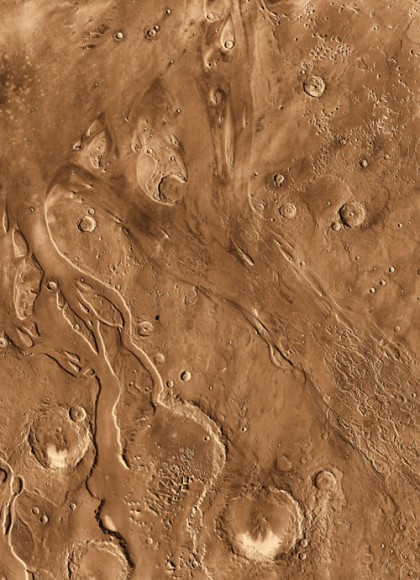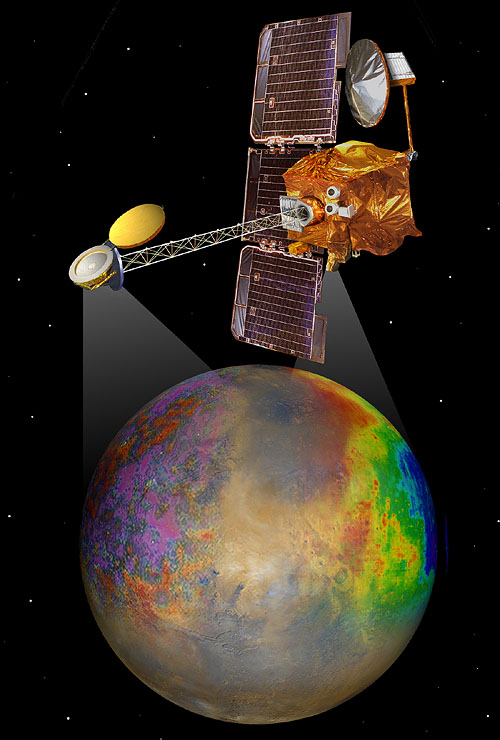[/caption]
Seems like everyone at Mars is getting an extended mission these days – every spacecraft, that is. The Mars Odyssey orbiting spacecraft, the longest-serving of six spacecraft now studying Mars, has gotten another two-year extension of its mission. And mission extensions are great opportunities to try something new, so Odyssey is altering its orbit to get a different and better look at Mars with its Thermal Emission Imaging System which maps minerals on Mars in infrared. During this third mission extension, which goes through September 2010, Odyssey will also be able to point its camera with more flexibility than ever before. Odyssey is another Energizer Bunny-like spacecraft: it has been going and going since it reached Mars in 2001.
The orbit adjustment will allow Odyssey’s Thermal Emission Imaging System to look down at sites when it’s mid-afternoon, rather than late afternoon, as it has been doing so far. The multipurpose camera will take advantage of the infrared radiation emitted by the warmer rocks to provide clues to the rocks’ identities.
“This will allow us to do much more sensitive detection and mapping of minerals,” said Odyssey Project Scientist Jeffrey Plaut of NASA’s Jet Propulsion Laboratory, Pasadena , Calif.
The mission’s orbit design before now used a compromise between what works best for the Thermal Emission Imaging System and what works best for another instrument, the Gamma Ray Spectrometer.
To change its orbit, the operations team at JPL and Lockheed Martin Space Systems in Denver fired Odyssey’sthrusters for nearly 6 minutes on Sept. 30, the final day of the mission’s second two-year extension.

“This was our biggest maneuver since 2002, and it went well,” said JPL’s Gaylon McSmith, Odyssey mission manager. “The spacecraft is in good health. The propellant supply is adequate for operating through at least 2015.”
Odyssey’s orbit a sun-synchronous polar orbit at Mars. The local solar time has been about 5 p.m. at whatever spot on Mars Odyssey flew over as it made its dozen daily passes from between the north pole region to the south pole region for the past five years. (Likewise, the local time has been about 5 a.m. under the track of the spacecraft during the south-to-north leg of each orbit.)
From last week’s thruster maneuver, that synchronization will gradually change over the next year or so. Its effect is that the time of day on the ground when Odyssey is overhead is now getting earlier by about 20 seconds per day. A follow-up maneuver, probably in late 2009 when the overpass time is between 2:30 and 3:00 p.m., will end the progression toward earlier times.
This will also allow the camera away to be pointed in different directions, instead of just the straight-down pointing that has been used throughout the mission. Doing this will allow the team to fill in some gaps in earlier mapping and also create some stereo, three-dimensional imaging.
The downside of this is one instrument will likely stop being used. The gamma ray detector, one of three instruments in Odyssey’s Gamma Ray Spectrometer suite, needs a later-hour orbit to avoid overheating of a critical component. But the neutron spectrometer and high-energy neutron detector are expected to keep operating.
The Gamma Ray Spectrometer provided dramatic discoveries of water-ice near the surface throughout much of high-latitude Mars, the impetus for NASA’s Phoenix Mars Lander mission. The gamma ray detector has also mapped global distribution of many elements, such as iron, silicon and potassium, a high science priority for the first and second extensions of the Odyssey mission. A panel of planetary scientists assembled by NASA recommended this year that Odyssey make the orbit adjustment to get the best science return from the mission in coming years.
Odyssey will continue providing crucial support for Mars surface missions as well as conducting its own investigations. It has relayed to Earth nearly all data returned from NASA rovers Spirit and Opportunity . It shares with NASA’s Mars Reconnaissance Orbiter the relay role for Phoenix. It has made targeted observations for evaluating candidate landing sites.
Source: Odyssey home page


So how much are you being sponsored by Duracell for that tag line?
Not to mention future rolls supporting MSL and maybe Exomars. (If they get launched)
On a different subject, anyone notice that the JPL Cassini blog is down?
Er, Energizer and Duracell are two different brands. If you’re going to be snarky, at least try to get your comment actually correct…
its a shame the media doesnt cover stories like this… as soon as a probe crashes or fails its front page news but amazing success is deemed as un-newsworthy… pity really as the general publis knows of nothing but failure, no wonder they see nasa and space exploration as a waste of our money.
@Ray
I hear that chief, most news outlets could just sum up thier headlines with a top ten list of Who Screwed Up Today. (spoiler 8 of those 10 don’t actually matter…to anybody)